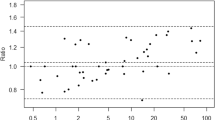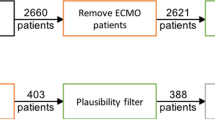Abstract
Objective. To evaluate the VIA V-ABG (VIA Medical Corp.) point-of-care blood gas and chemistry monitor in healthy human volunteers, with particular emphasis on the measurement of blood gases. Methods. Experimental conditions were varied by intermittently subjecting volunteers to either isocapnic hypercapnia (end-tidal (ET), PETCO2 = 50 ± 2 mmHg, ETPO2 = 130 ± 5 mmHg) or isocapnic hypoxia (PETCO2 = 42 ± 2, PETO2 + 45 ± 2 mmHg) in addition to room air breathing. Measurements by the VIA V-ABG device were compared with paired samples and measurements performed by two ABL Radiometers (505 and 500). Analysis of results includes bias and precision plots and comparison of results with minimal performance criteria as established by CLIA. Results. Nineteen volunteers yielded 222 matched samples. The range of values were 7.32-7.61 for pH, 20.9–51.6 mmHg for PCO2, 27.9–184.5 mmHg for PO2, 134-141 mmol/l for Na, 3.1–4.1 mmol/l for K, and 30.0–50.4% for hematocrit. Bias and precision (± 2 sd) for pH was 0.01 and 0.04, for PCO2 was 0.4 and 4.8, for PO2 was 1.0 and 17.0, for Na was −0.3 and 5.2, for K was 0.1 and 0.2, and for Hct was 2.0 and 5.4. Conclusions. Over the range of blood gas values assessed, blood gas measurements by the VIA V-ABG device were clinically acceptable and met minimal performance criteria utilizing current Medicare CLIA proficiency standards. Performance criteria were also met by the VIA V-ABG device for Na, K, and Hct measurements but the range of values was too narrow to allow characterization of clinical acceptability. The VIA V-ABG device appears to perform well compared with the results which have been published for other point-of-care devices. Comparison between different studies investigating point-of-care devices is difficult due to several factors (range of values measured, comparison device, population studied, etc.). Some of these instruments, including the VIA V-ABG device, may serve quite well as point-of-care devices to perform certain tests at the bedside. Whether or not any of these devices can substitute for traditional laboratory blood gas and chemistry measurements remains an issue that is not adequately studied.
Similar content being viewed by others
REFERENCES
Smith ML, Smith NT, Nesseler ESE. In-line measurement of electrolytes, glucose, and blood gases. Int Anesthesiol Clin 1993; 31(3): 159-80
Wong DK, Jordan WS. Microprocessor-based near real-time bedside blood chemistry monitor. Int J Clin Monit and Comput 1992; 9: 95-102
Bland JM, Altman DG. Statistical methods for assessing agreement between two methods of clinical measurement. Lancet 1986; 307-310
Ehrmeyer SS, Laessig RH, Leinweber JE, Oryall JJ. 1990 Medicare/CLIA final rules for proficiency testing: minimum intralaboratory performance characteristics (CV and Bias) needed to pass. Clin Chem 1990; 36(10): 1736-1740
MacIntyre NR, Lawlor BL, Carstens D, Yetsko D. Accuracy and precision of a point-of-care blood gas analyzer incorporating optodes. Resp Care 1996; 41(9): 800-804
Shelledy DC, Smith WA. A Comparison of the i-STAT system and corning 278 for the measurement of arterial blood gas values. Resp Care 1997; 42(7): 693-697
Wahr JA, Lau W, Tremper KK, Hallock L, Smith K. Accuracy of a new, portable, hand-held blood gas analyzer, the IRMA ®. Anesthesiology 1995; 83(3A): A426.
Zollinger A, Spahn DR, Ganter M et al. Accuracy of continuous intra-arterial blood gas monitoring during thoracoscopic surgery. Anesthesiology 1995; 83(3A): A423.
Zaloga GP, Roberts PR, Black K et al. Hand-held blood gas analyzer is accurate in the critical care setting. Crit Care Med 1996; 24(6): 957-962.
McKinley BA, Nguyen MT, Parmley CL. Preliminary clinical trial of a new arterial blood gas monitor. Anesthesiology 1996; 85(3A): A449.
Author information
Authors and Affiliations
Rights and permissions
About this article
Cite this article
Bailey, P.L., McJames, S.W., Cluff, M.L. et al. Evaluation in Volunteers of the VIA V-ABG Automated Bedside Blood Gas, Chemistry, and Hematocrit Monitor. J Clin Monit Comput 14, 339–346 (1998). https://doi.org/10.1023/A:1009991527491
Issue Date:
DOI: https://doi.org/10.1023/A:1009991527491




